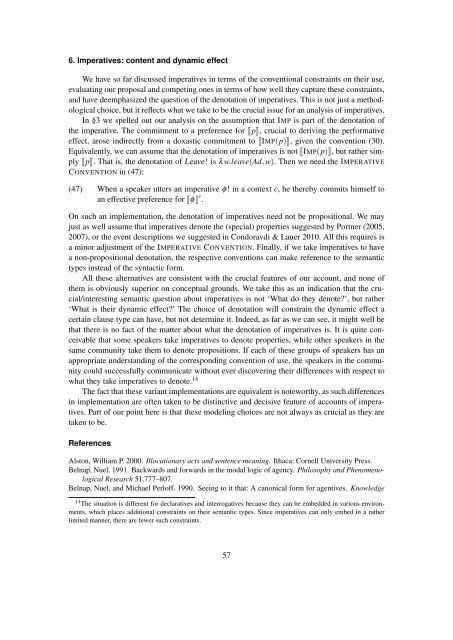Empirical Issues in Syntax and Semantics 9 (EISS 9 ... - CSSP - CNRS
Empirical Issues in Syntax and Semantics 9 (EISS 9 ... - CSSP - CNRS
Empirical Issues in Syntax and Semantics 9 (EISS 9 ... - CSSP - CNRS
You also want an ePaper? Increase the reach of your titles
YUMPU automatically turns print PDFs into web optimized ePapers that Google loves.
6. Imperatives: content <strong>and</strong> dynamic effect<br />
We have so far discussed imperatives <strong>in</strong> terms of the conventional constra<strong>in</strong>ts on their use,<br />
evaluat<strong>in</strong>g our proposal <strong>and</strong> compet<strong>in</strong>g ones <strong>in</strong> terms of how well they capture these constra<strong>in</strong>ts,<br />
<strong>and</strong> have deemphasized the question of the denotation of imperatives. This is not just a methodological<br />
choice, but it reflects what we take to be the crucial issue for an analysis of imperatives.<br />
In §3 we spelled out our analysis on the assumption that IMP is part of the denotation of<br />
the imperative. The commitment to a preference for p, crucial to deriv<strong>in</strong>g the performative<br />
effect, arose <strong>in</strong>directly from a doxastic commitment to IMP(p), given the convention (30).<br />
Equivalently, we can assume that the denotation of imperatives is not IMP(p), but rather simply<br />
p. That is, the denotation of Leave! is λw.leave(Ad,w). Then we need the IMPERATIVE<br />
CONVENTION <strong>in</strong> (47):<br />
(47) When a speaker utters an imperative φ! <strong>in</strong> a context c, he thereby commits himself to<br />
an effective preference for φ c .<br />
On such an implementation, the denotation of imperatives need not be propositional. We may<br />
just as well assume that imperatives denote the (special) properties suggested by Portner (2005,<br />
2007), or the event descriptions we suggested <strong>in</strong> Condoravdi & Lauer 2010. All this requires is<br />
a m<strong>in</strong>or adjustment of the IMPERATIVE CONVENTION. F<strong>in</strong>ally, if we take imperatives to have<br />
a non-propositional denotation, the respective conventions can make reference to the semantic<br />
types <strong>in</strong>stead of the syntactic form.<br />
All these alternatives are consistent with the crucial features of our account, <strong>and</strong> none of<br />
them is obviously superior on conceptual grounds. We take this as an <strong>in</strong>dication that the crucial/<strong>in</strong>terest<strong>in</strong>g<br />
semantic question about imperatives is not ‘What do they denote?’, but rather<br />
‘What is their dynamic effect?’ The choice of denotation will constra<strong>in</strong> the dynamic effect a<br />
certa<strong>in</strong> clause type can have, but not determ<strong>in</strong>e it. Indeed, as far as we can see, it might well be<br />
that there is no fact of the matter about what the denotation of imperatives is. It is quite conceivable<br />
that some speakers take imperatives to denote properties, while other speakers <strong>in</strong> the<br />
same community take them to denote propositions. If each of these groups of speakers has an<br />
appropriate underst<strong>and</strong><strong>in</strong>g of the correspond<strong>in</strong>g convention of use, the speakers <strong>in</strong> the community<br />
could successfully communicate without ever discover<strong>in</strong>g their differences with respect to<br />
what they take imperatives to denote. 14<br />
The fact that these variant implementations are equivalent is noteworthy, as such differences<br />
<strong>in</strong> implementation are often taken to be dist<strong>in</strong>ctive <strong>and</strong> decisive feature of accounts of imperatives.<br />
Part of our po<strong>in</strong>t here is that these model<strong>in</strong>g choices are not always as crucial as they are<br />
taken to be.<br />
References<br />
Alston, William P. 2000. Illocutionary acts <strong>and</strong> sentence mean<strong>in</strong>g. Ithaca: Cornell University Press.<br />
Belnap, Nuel. 1991. Backwards <strong>and</strong> forwards <strong>in</strong> the modal logic of agency. Philosophy <strong>and</strong> Phenomenological<br />
Research 51.777–807.<br />
Belnap, Nuel, <strong>and</strong> Michael Perloff. 1990. See<strong>in</strong>g to it that: A canonical form for agentives. Knowledge<br />
14 The situation is different for declaratives <strong>and</strong> <strong>in</strong>terrogatives because they can be embedded <strong>in</strong> various environments,<br />
which places additional constra<strong>in</strong>ts on their semantic types. S<strong>in</strong>ce imperatives can only embed <strong>in</strong> a rather<br />
limited manner, there are fewer such constra<strong>in</strong>ts.<br />
57











